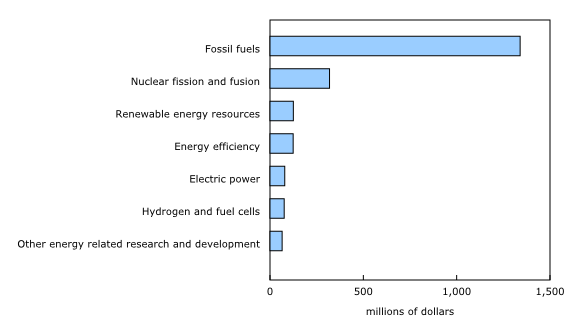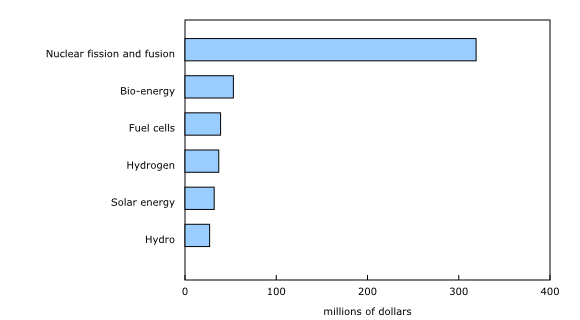Energy research and development expenditures by area of technology, 2014
Archived Content
Information identified as archived is provided for reference, research or recordkeeping purposes. It is not subject to the Government of Canada Web Standards and has not been altered or updated since it was archived. Please "contact us" to request a format other than those available.
Released: 2017-04-19
Two-thirds of energy research and development by businesses was related to fossil fuels
Of the $18.5 billion that companies spent on in-house research and development (R&D) in Canada in 2014, $2.1 billion was directed to energy-related technologies.
Energy-related R&D expenditures span a diverse range of technologies and industrial sectors.
In 2014, over 60% or $1.3 billion of energy-related in-house R&D spending was connected to fossil fuels energy, ranging from coal, oil and natural gas production to fossil fuels transportation.
The remaining energy-related R&D expenditures of $800 million covered a variety of technologies, including: nuclear-related technology ($319 million or 15.0%); electric power production technologies ($79 million or 3.7%); renewables ($125 million or 5.9%); hydrogen and fuel cells technology ($76 million or 3.6%); and energy efficiency technologies for industry, transportation, residences and institutions ($124 million or 5.8%).
About three-quarters of energy R&D performed by energy-intensive sectors
Utilities and mining, quarrying, and oil and gas extraction, sectors generally considered energy intensive, spent $1.5 billion on energy-related in-house R&D in 2014.
Professional services companies spent $240 million on energy-related in-house R&D, with other services companies spending an additional $204 million. Manufacturers spent $189 million on energy-related in-house R&D in 2014.
Foreign-controlled companies account for just over one-fifth of energy research and development
Firms under foreign control accounted for just over one-fifth of all energy-related in-house R&D expenditures in 2014. These companies spent $432 million on energy-related R&D, three-quarters of which was dedicated to fossil-fuel technologies.
Energy-related in-house R&D was largely self-funded, with 89% ($1.9 billion) of funds coming from these R&D performers. Energy-related, in-house R&D performed under contract or on behalf of other Canadian organizations and governments amounted to $162 million (7.6%). Foreign-funding accounted for the remaining $66 million (3.1%) in 2014.
Companies spent over half a billion dollars on research and development for clean technology
Research and development in-house spending related to clean technology such as renewable energy resources, nuclear, hydrogen and fuel cells, energy efficiency, and carbon capture amounted to more than $600 million in 2014. Of these clean technology in-house R&D expenditures, nuclear-related led ($319 million), followed by renewable energy resources ($125 million), energy efficiency related technology ($124 million), hydrogen and fuel cells ($76 million) and expenditures on carbon capture.
Note to readers
Energy-related technologies
Energy-related technologies include: fossil fuels, renewable energy sources, nuclear fission and fusion, electric power, hydrogen and fuel cells, energy efficiency and other energy-related technologies.
Survey redesign
The Energy Research and Development Expenditures by Area of Technology survey data are collected by the Annual Survey of Research and Development in Canadian Industry. Several aspects of the survey have been redesigned, including the collection method and the data processing system. Users should, therefore, exercise caution when comparing 2014 data with historical datasets. For more information on methodology changes consult Definitions, data sources and methods and go to The Integrated Business Statistics Program in the Behind the data feature of our website to learn more about data production.
Starting in reference year 2014, the reference period changed from the fiscal year ending in the calendar year (reference year 2013) to the fiscal year ending within the fiscal period from April 1, 2014, to March 31, 2015 (reference year 2014).
Contact information
For more information, or to enquire about the concepts, methods or data quality of this release, contact us (toll-free 1-800-263-1136; 514-283-8300; STATCAN.infostats-infostats.STATCAN@canada.ca) or Media Relations (613-951-4636; STATCAN.mediahotline-ligneinfomedias.STATCAN@canada.ca).
- Date modified:



